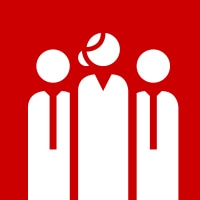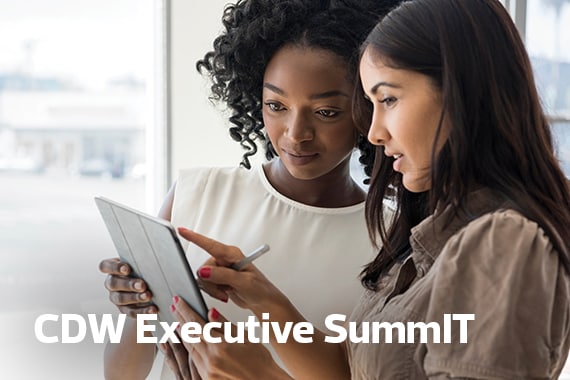August 01, 2022
CDW Exec-Connect: Past Tech, Forward Thinking
4 Ways to build and adapt multi-generational workplace communication channels
What is Gen Z Talking About?
The other day, my 20-year-old son was talking, and I don’t even know what language he was speaking. It was something around the notion that someone’s home address had been made public. “It’s doxing. They’ve been doxed,” my 18-year-old daughter interpreted.
Me: (Crickets) I still don’t get it. [One slang term replaced another slang term; this was not helpful.]
Keeping track of Gen Z digital slang, can be difficult even for someone who works at a tech company and who on any given day will collaborate on at least six different messaging and chat platforms from Slack to WhatsApp and three to four different video conferencing solutions.
The communication snags I run into with my adult children, started me thinking about the rapid evolution Digital Workspace Solutions have made over the last 30 years.
“
When your hand is forced, it’s not a true culture shift, unless your implementation and adoption of technology is on a refresh cycle.
”
Tara Barbieri
VP & GM, Integrated Tech Orchestration
When the IRC was Kewl
In August of 1993 as I arrived for my freshman year at college, I brought with me a few essentials: Pen and paper, a “portable” thirty-pound television and VCR, and the crème de la crème of its time, a Digital Equipment 386dx.
A computer was a requirement for freshman entering the engineering program at my school. It’s common today, but back then having a personal computer in your dorm room was a new thing for Gen X students, like me. I very quickly got on IRC (Internet Relay Chat)—a real-time, text-based platform that allowed computer users to communicate via the World Wide Web (which was also new for public consumption). We had email, but we checked our physical mailboxes more often hoping for care packages and letters. Email was for the more formal communication we had with professors or (shudder to think) the bursar’s office inquiring about the $2,800 we borrowed for the 386dx.
After college, in my very first job working as a supervisor in a credit department at a tech sales company, I dumped my rolodex in favor of Outlook Contact cards. Yet email still took a back seat to face-to-face communication. We all had phones and emails but people didn’t communicate that way. We literally walked the aisles. I got up from my desk every few hours to interact with my staff and if they needed me, they came to my desk.
BRB, GTG Check my Modem
Later in the 90s and early aughts, chat, via a desktop computer, became my go-to mode to communicate with staff, customers, peers, family, and friends. There were many different platforms, but it seemed that then everyone used Yahoo.
Then mobile devices started hitting the scene. I skipped the pager stage, so my first real memory of using a mobile device to communicate was via multi-tap texting prior to the invention of T9 keypads (predictive texting using nine keys). Before T9, you had to push the number “5” four or five times to get to the letter “L.” I’ve never been a license plate texter. The sentence “R U available?” isn’t my style. I’ve always written complete sentences with punctuation. Mostly, as people would text me I would call them back. So, I was relieved when BlackBerrys with their standard QWERTY keyboards made it easier to write full sentences.

It’s Complicated
Around the same time, one-to-one communication lost favor to one-too-many and social networks appeared. I saw the benefit in LinkedIn and enjoyed Instagram (it was mostly flowers and bugs then), but I never wanted to be on Facebook. Yet, in 2011 I finally conceded after the following conversation with one of my sisters about another sister’s newborn.
My sister: “Isn’t the baby so cute?”
Me: Um, she had the baby?
My Sister: Yeah, it’s on Facebook.
Me: I’m literally babysitting her other child right now! How do I not get informed when their sibling is born?
My sister, matter-of-factly: Well, you gotta get on Facebook.
Despite my insistence that I deserved a phone call, it became apparent that I would have to create a Facebook account, or I wouldn’t get to know what’s going on in my family’s lives. "People are NOT going to just call you anymore," she said.
And Therein, Lies the Rub
Thanks for taking this walk down memory lane. The journey demonstrates just how impactful digital technology has been to efficient communication…and that the pace of change isn’t going to stop anytime soon. Get aligned or lose out. So, how do organizations continue to create connections in a workplace that hosts employees from up to as many as five generations and who all approach communication with a different POV on how to use divergent technologies, devices, apps, and vernacular?
If you’re looking at me for one answer, prepare to be disappointed. It doesn’t exist. It’s not about any one generation’s mode of communication being better than another. So, Boomers and Millennials step back from throwing rocks at one another. Here are the four lessons I’ve learned through the decades about keeping your communication aligned and focused even in the midst of technological turnover:
1) Don't Assume
Assumptions and stereotypes have no place in building collaborative models. Not all Traditionalists (those born between World War I and World War II) are luddites. Many of our US Senators and C-suite business professionals are from the Silent Generation—the nickname given to the Traditionalists—and they are all daily active users of technology. At 91 years old, Warren Buffet is still chairman and CEO of Berkshire Hathaway. And according to the Pew Research Center, a larger percent of Baby Boomers (born 1946 to 1964) are participating in the labor force longer than prior generations. They aren’t working just to collect a check. They want to innovate, collaborate, and execute alongside Gen X, Millennial and Gen Z coworkers.
Additionally, a study done by the Harvard Business Review revealed that when trainers believed that they were teaching an older person how to do a computer task, they lowered their expectations and provided worse training than when teaching a younger person. This perpetuates the stereotype. Truth be told, more seniors are becoming inventors, according to the United Inventor’s Association. Alternatively, there are subsets of the Generation Z population who aren’t digital natives and who also expect training on things they were assumed to know.

2) Adopt a Multimodal Perspective
The belief that everyone is sitting in front of a computer all day is another assumption that can alienate large swaths of your organization. Here at CDW, we’ve been more intentional around thinking through when its best to let people consume information the way they prefer.
In addition to many white-collar workers tied to desktops, we also have salespeople meeting with customers offsite and at trade events, configuration workers at distribution centers or workers out in the warehouse picking products who may only check their email a few times a week, along with software engineers who primarily communicate via Slack or G-chat.
Add in coworkers, who need accommodations for disabilities, and it’s clear one size doesn’t fit all. If we want to reach all coworkers, we have to go multi-modal. So, when my Integrated Tech team creates a newsletter, we might email it but also send links to a 90-second video or podcast with closed captions, and create a version of it that can be printed and posted in the distribution center.
Like all organizations we’ve made missteps and have had to learn and adjust as we grow. Innovative collaboration software won’t automatically make everything seamless. We’ve missed opportunities to update whole departments in a timely fashion because someone assumed they were on a platform or distribution list. Even technology that should work, won’t work unless you’re actively strategizing to think through all of the variables for communicating with different people and teams.
3) Keep an Open Dialogue
As leaders it’s critical to be exact in explaining your communication preferences and expectations. When a new coworker ladders up to me, I share with them a document which summarizes “How Tara prefers to be communicated with.” It very tactically, explains my views on email, text, chat, and phone calls. For example, to me email is not for urgent requests, but out-of-the blue phone calls and chats are. I encourage them to share their views with me so we can get on the same page and agree a compromise if our views differ greatly on any communication mode / platform.
And, equally important is when you find yourself on a project team. Agreeing on the mode of collaboration – both communication standards and artefact handling – up front can be critical to starting on the right foot and achieving progress as a team early in the project.
I’m at the point where I can almost see a profile of the standard user based on which tool they use to communicate with me. I use my iPhone text for people who are mostly in the field selling and WhatsApp for the international teams at CDW. The technical and development teams chat with me on Slack all day, and people in the backbone departments interface via Microsoft Teams. Be humble enough to ask your workforce about their preferences and adopt their tactics if it makes sense. All teams operate differently and depending on the situation they deserve the autonomy to not be micromanaged into using a form of communication that doesn’t work for them.
4) Refresh and Retrain Regularly
Finally, change is inevitable. In a year or two many of the collaboration solutions adopted in the last decade may be supplanted by new ones. That might sound scary for some, but the future path is not the problem. Stagnation is. The Pandemic required us to take one monumental step forward. But, in its aftermath, some industries will stop innovating, and even revert back. When your hand is forced, it’s not a true culture shift, because you’re changing under duress. If you want to maximize this opportunity to create a culture shift, you must focus on the implementation and adoption of the technology on a refresh cycle. One and done innovation will not serve you, your workforce or your business goals for long
Organizations, like CDW are great at adopting new business communication solutions. Our customers and partners are always driving us forward. We have a proliferation of Sharepoint sites, Google hangouts, Teams channels (Cisco and Microsoft), Slack chats, and the like. If you’re like us, it’s important to stop and make sure leaders aren’t abandoning late adopters or those averse to change without first considering if a new communication platform or device is even necessary, and then if so, sufficiently training employees on how to use it.
The Future of Work
As leaders looking to the future, we must remember that as our multi-generational teams work toward one goal, it’s our responsibility to consider all of the disparate points of view, necessary accommodations, and use cases at play. As we work remotely, in offices, on planes, around classrooms, manufacturing plants and elsewhere, when we communicate, whether digitally or otherwise we have to smash assumptions, be transparent, adopt multimodal channels and refresh, refresh, refresh.
It's not too late to register and join us at the CDW Executive SummIT Series in August
About the Author
Tara Barbieri is general manager and vice president of integrated technology orchestration for CDW. She is responsible for the development, management and governance of CDW services. Orchestration teams include Services Operations, Warranty & Renewals, Strategic Programs and our IP engine with R&D and CDW Built.
Tara joined CDW-G in September 2003. She served as director of program sales where her team handled demand generation, opportunity development, capture strategies, proposal preparation and contract negotiations for all segments of the CDW business. Prior to working at CDW-G, Barbieri’s career spanned nearly a decade, including roles as an account manager and concluding as director of contracts for Micro Warehouse, a direct reseller of branded IT products and services to business.
Tara is an executive sponsor of the BRAVE business resource group focused on equity for LGBTQ+ coworkers and an active sponsor for CDW’s Women’s Opportunity Network, which helps to advance the careers of women in IT through mentoring, facilitated networking and formal leadership training. She is also the Chief Steward of the CDW Strava club where you can join and follow along with our monthly focus and friendly competition.



